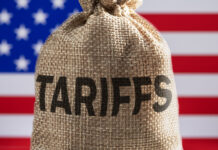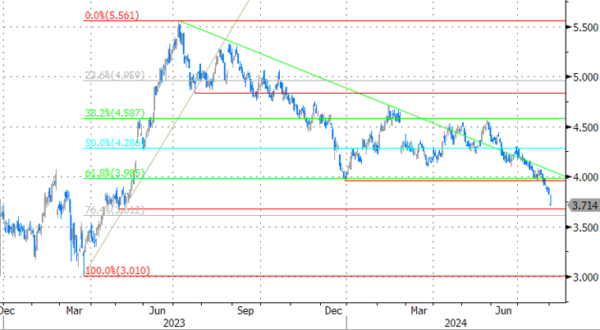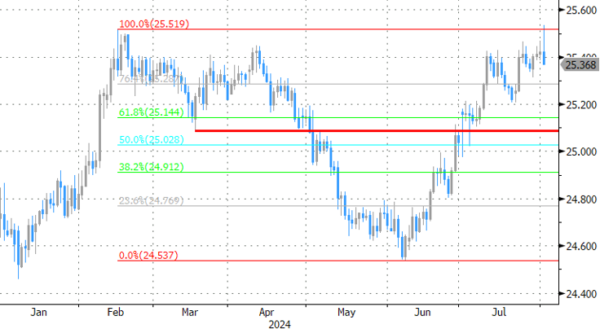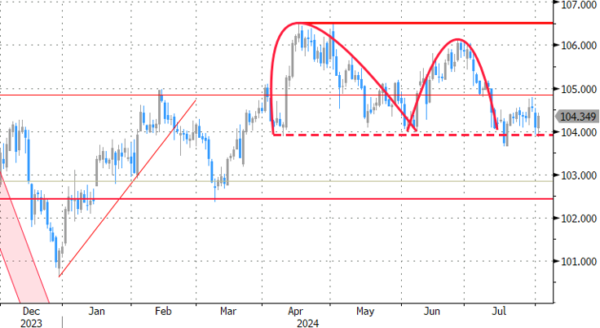Markets
After the Fed’s most clear pivot towards imminent rate cuts yesterday, the Bank of England thought it could do even better. It cut the policy rate by 25 bps to 5% in a 5-4 split vote. For “some” in the group of 5 it was a finely balanced decision – similar to what was the case in June when the majority decided to keep rates unchanged. This was also reflected in the rationale to “reduce slightly the degree of policy restrictiveness”. It was the result of a balancing act that leads us to label it a “hawkish cut”. Several inflation indicators, including services and core inflation, are still too high and risks remain tilted to the upside. But they are expected to normalize further. Based on the market implied interest rate path, headline CPI would – after temporarily bouncing back to 2.7% by the end of the year – ease towards 1.7% and 1.5% in respectively two and three years time. This disinflation is facilitated by the economy growing below potential, creating a margin of slack under the weight of a still-restrictive monetary policy. This feels at odds with the recent data. Indeed, the BoE noted that GDP has picked up sharply so far this year before downplaying it by saying that underlying momentum appeared weaker. GDP is seen growing 0.8% by 2025Q3 and will pick up to 1.4% and 1.7% in the years after. The economy will be in excess supply all this time. Given how the decision was not at all a straightforward one, the BoE abstained from any forward guidance. Instead, it opted to continue “to monitor closely the risks of inflation persistence” and to “decide the appropriate degree of monetary policy restrictiveness at each meeting.” The Bank of England basically copy-pasted the ECB strategy of very gradually unwinding peak restrictiveness, on a pace determined by incoming data. Both inflation and economic data give the BoE less room to maneuver compared to Frankfurt though. Markets nevertheless add rate cutting bets, particularly for the second half of next year. Front end yields drop 11.8 bps, though a large chunk already occurred prior to the BoE while weak (but second tier) US data a bit later accelerated the downleg. Sterling lost some ground in the wake of a decision that was not a 100% expected, but losses could have been larger given the sizeable yield drop. EUR/GBP only trades marginally higher around 0.843. US unit labor costs came in to the low side of expectations (0.9% in Q2) and weekly jobless claims rose to the highest in 11 months (249k, topping 236k estimates). The latter add to growing labour market concerns and comes a day after the Fed said it turned attentive to both sides of its dual mandate. US yields swapped 2 bps gains for losses after already declining >10 bps yesterday. German yields gapped lower at the open, catching up with the US late yesterday. Moves down amount to slightly over 3 bps. The dollar mostly gained, including against the Japanese yen (USD/JPY 150.57) and the euro (EUR/USD 1.08 is fighting for survival). Stock markets drop less than 1% in Europe but open higher in the US.
News & Views
The Czech National Bank cut the policy rate 25 bps to 4.50% today. The press conference as well as statement is due later today. In the run-up to today’s decision markets were split on a 25 or 50 bps outcome after, amongst others, the CNB vice governor flagged the possibility of another big step at this meeting. Until then, markets didn’t really consider the option given that the previous 50 bps cut was already not as straightforward as the previous ones and given the recent CZK depreciation move. It appears that the latter now convinced CNB policymakers to take a more cautious cutting approach. EUR/CZK earlier on the day briefly jumped to the highest since March 2022 before paring gains to trade little changed around 25.43 on a daily basis.
The OPEC+’s monitoring committee did not issue any specific recommendation during today’s meeting. A statement on the website noted the “high overall conformity” to the current output curbs and reiterated the possibility to pause or even reverse the planned unwinding of voluntary production cuts. In June, OPEC+ agreed to first extend some 2.2 mln of voluntary output curbs that were originally scheduled to end that month to September 2024 and then to roll them back gradually on a monthly basis through September 2025. The move roiled the oil market as increased supply was expected against the background of weakening demand (especially from China). After plummeting to as low as $77/b prices then recovered $10 only to slide again in recent weeks. The recent geopolitical developments have supported oil again somewhat in recent days.
Graphs
UK 2-yr yield hits new YtD low as Bank of England delivers “hawkish cut”
EUR/CZK: sigh of relief for the Czech crown as CNB slows down cutting pace from 50 to 25 bps
DXY: trade-weighted dollar is holding up well despite Fed readying first (but priced in) rate cut for September
US 10-yr yield is heavily testing support around 4% as weak jobless claims add to growing labour market concerns/risks
















